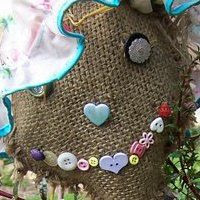From freezing conditions to a little taste of spring, my bug house workshop at a Children's Centre in Eastbourne was lots of fun. The centre is in the middle of a housing estate, a long way from town, a long way from the sea, cut off by the railway line. Lots of streets that all look the same and are easy to get lost in. "Hazelwood Avenue" giving an indication of what was once there. Centres like these provide playgroups with free snacks, advice, support and information for families and carers with babies and toddlers. During the school holidays older children often come along too. I arrived with a big bundle of bamboo canes, straw and dry cow parsley stems, a bag full of plastic bottles cut in half, some tin cans (ring pull ones only as the edges aren't sharp), wool, string, wire, some homemade playdough and permanent markers. I set up a couple of small vices on the tables.
We made homes for solitary bees. The female bee lays an egg on top of a mass of pollen at the end of a hollow tube, she then seals the entrance with a plug of mud. Hollow stems such as old bamboo canes make good nest sites. Playdough was put in the bottom of the can or bottle then it was packed with bamboo canes and dry cow parsley stems. The older children drew bug designs on the outside using permanent markers. All the children, except the very young ones, enjoyed cutting the bamboo to size using the little hacksaws. Wire or wool was wrapped around the outside and a loop made for hanging. Best placed in a sunny spot or hung on a south-facing wall or fence as solitary bees like warmth.
The children also packed bottles with a mixture of rolled cardboard, straw and canes. They took them home to see if any bugs would move in for them to investigate. An average garden could hold over 2,000 different species of mini bugs or invertebrates. Very few creatures cause significant damage to our flowers, fruit and veg and are the 'pests'. Many more creatures help us to control the pests. By creating homes for them we can encourage a diverse range of beneficial bugs in our gardens by giving the places to hide and hibernate. Lacewings and ladybirds and their larvae eat aphids which damage plants. Woodlice and millipedes help to break down woody material. They are essential parts of the gardening recycling system. Dead wood is an increasingly rare habitat as we tidy our gardens, parks and amenity woodlands. Even just a bundle of stems and sticks left in a corner will encourage mini bugs to move in.
Subscribe to:
Post Comments (Atom)


















It looks great fun, Lorna. A great use for odds and ends and old plastic bottles!
ReplyDeleteWhat a great idea. Glad the weather was fine for your activities. xx
ReplyDeleteSome good ideas there - interesting post - and it is always good to get children started early thinking about these things.
ReplyDeleteIt looks like the weather cooperated for you. Your workshop sounds like a great idea, the children will have got so much out of it, and so will the bugs.
ReplyDeleteSounds like great fun! I bet the kids enjoyed it!
ReplyDeleteJune
Looks like you and the children had great fun and the sun was shining.
ReplyDeleteWe were so lucky with the weather considering just how freezing it was just a few days before. We all had a really great time :)
ReplyDeleteLooks fun and great! So sunny day you`ve got there :o)
ReplyDeleteBy the way I have nominated you for the versatile blogger award and hope you will accept,although I won't be offended if you don't You can find out more details on my blog.
Kisses
Natasha
I've been researching 'Bug-Hotels' on Pinterest but all the ones I've found look like they need some proper workbench skills to accomplish. This looks like a much easier way to build one! I might have to make one myself ;)
ReplyDeleteWe were thinking of using bark as a roof for our mini homes but I didn't want to go stripping bark off dead trees as it's already home for the mini beasts!! The plastic bottles and tin cans worked well.
ReplyDeleteFor a good big hotel pallets laid on top of each other are ideal. Put a board over the second last pallet, then the one on top can be filled with compost and planted up. Just fill up all the gaps with a variety of broken pots, stems, straw, etc.